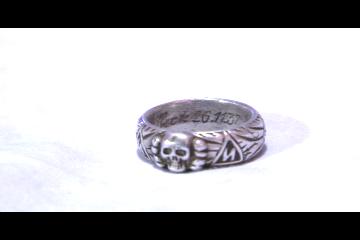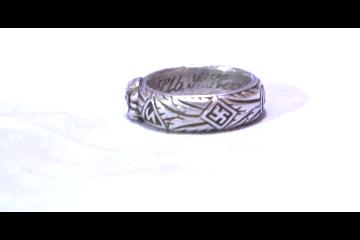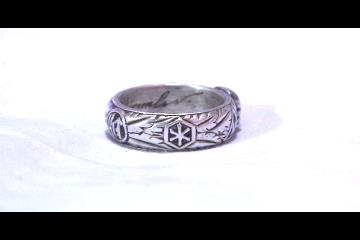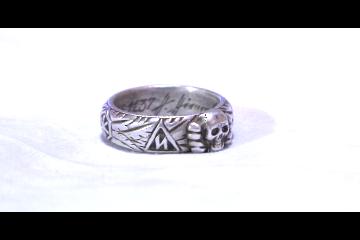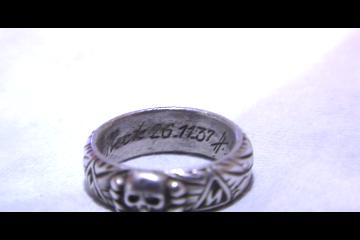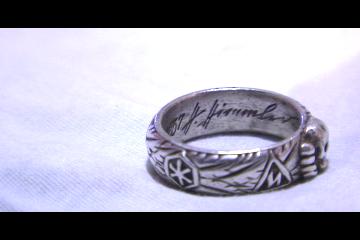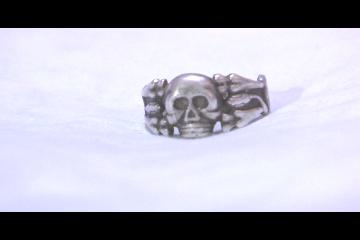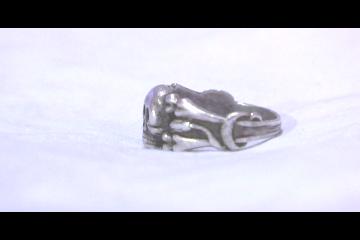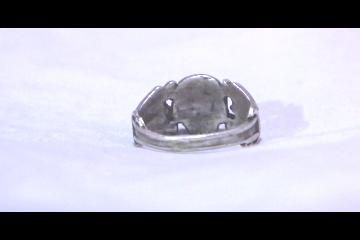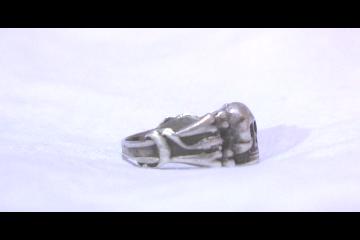One of the most obscure yet most potent of all SS uniform accoutrements was the Totenkopfring der SS ('The Honour Ring'), or SS Death's Head Ring, instituted by Himmler on 10 April 1934. The Totenkopfring was not classed as a national decoration, as it was in the gift of the Reichsfuhrer. However, it ranked as a senior award within the SS brotherhood, recognizing the wearer's personal achievement, devotion to duty, and loyalty to the Fuhrer and his ideals.
The concept and runic form of the ring was undoubtedly adopted by Himmler from pagan German mythology, which related how the great God Thor possessed a pure silver ring on which people could take oaths much as Christians swear on the Bible, and how binding treaties were carved in runes of Wotan's spear. The Death's Head Ring comprised a massive band of oakleaves deeply embossed with a totenkopf and a number of symbolic runes. Each piece was cast and exquisitely hand-finished by specially commissioned jewellers, working for the renowned firm of Gahr in Munich, letters 'S.lb' (the abbreviation for Seinem lieben' or, roughly, 'To Dear') followed by the recipient's surname, the date of presentation and a facsimile of Himmler's signature.
Initially, the weighty silver ring was reserved primarily for those Old Guard veterans with SS membership numbers below 5000 but qualifications for award were gradually extended until, by 1 August 1939, the following persons were eligible to wear it:
(i) Members of any rank whose numbers were below 10 000;
(ii) Officers who joined the SS before 20 January 1933;
(iii) Officers who joined the SS after 30 January 1933 and had served for three years;
(iv) Officers who had served for two years, having been prevented from joining the SS earlier than they did because of their membership of the army or police prior to 30 January 1933;
(v) Officers who had been members of the SS for two years, having transferred directly into the organization from active uninterrupted membership in the NSDAP, SA, NSKK, or HJ;
(vi) Members of any rank holding the Coburg Badge;
(vii) Members of any rank holding the Golden Party Badge;
(viii) Officers and NCOs who were members of both the police and the Nazi Party before 30 January 1933;
(ix) Officers who resided in Austria before the Anschluss and were members of the outlawed Austrian SS during that time, provided they had been officers for at least two years;
(x) Officers who resided in the Sudetenland and became SS members before 31 December 1938, provided they had been officers for at least two years;
(xi) Officers who resided in the Memel District and became SS members before 1 June 1939, provided they had been officers for at least two years;
(xii) Members of any rank who did not fulfill any of the above criteria but were classed as 'Special Cases' by the Reichsfuhrer-SS. This category might include honorary officials, or SS men who had performed particularly arduous tasks.
When a serving ring holder died, his relatives could retain his citation but had to return his ring to the SS Personalhauptamt, which arranged for its preservation at the Wewelsburg Castle in permanent commemoration of the holder. Similarly, if a holder fighting with the Wehrmacht or Waffen-SS was killed in action, his ring had to be retrieved from the body by members of his unit and returned by the unit commander to the SS Personalhauptamt for preservation. In effect, the returned rings of dead SS men constituted individual military memorials and were cared for as such.
On 17 October 1944, the Reichsfuhrer-SS cancelled further manufacture and presentation of the Totenkopfring for the duration of the war. By that time 14 000 rings had been awarded. In the spring of 1945, on Himmler's orders, all the rings which had been returned to the SS Personalhauptamt for preservation as memorials were blast-sealed into a mountainside near Wewelsburg, the precise location of which was kept secret, to prevent their capture by the enemy. To this day, they have never been found.
